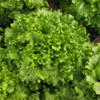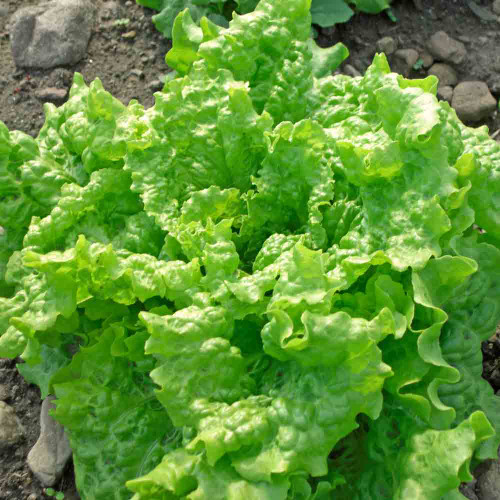Description
Green Salad Bowl Lettuce - Consistently Sweet & Tender
For over 70 years, Green Salad Bowl has remained a garden staple because it offers something special: reliable cool-season growth coupled with exceptional heat tolerance and a slow-bolting nature that keeps leaves sweet and crunchy longer than most. This resilience, recognized early with an All-America Selections award in 1952, allows gardeners to enjoy weeks of easy, cut-and-come-again harvests of tender, frilly leaves, even when other delicate lettuces have given up due to heat stress.
Details
A highly regarded lettuce known widely as 'Green Salad Bowl', this open-pollinated variety is easily recognized by its attractive rosette of deeply lobed, frilly green leaves. 'Green Salad Bowl' falls into the loose-leaf (or leaf) lettuce category, meaning it does not form a compact head like iceberg or butterhead types. More specifically, based on its characteristic leaf shape, it is often categorized within the "Oakleaf" subgroup of loose-leaf lettuces, distinguished by their deeply lobed leaves, resembling the shape of oak tree leaves. Plants initially grow somewhat upright before forming the open rosette, typically reaching 6 to 12 inches tall and 8 to 18 inches wide. The leaves are a light, bright green with wavy margins, appearing tender and delicate. Like all lettuces, it will eventually bolt in response to heat and long days, though this variety is noted for being slow to do so. It's adaptable for seasonal growing across USDA Zones 2-11.
History
The story of cultivated lettuce (Lactuca sativa) traces back thousands of years to ancient Egypt. Initially grown perhaps for seed oil, Egyptians selected varieties for edible leaves, and lettuce spread through the Greek and Roman empires (who named it lactuca for its milky sap) and eventually to the Americas via Columbus. 'Green Salad Bowl' lettuce itself is a more modern development with a distinguished pedigree. It was officially recognized as an All-America Selections (AAS) winner in 1952, signifying its superior garden performance shortly after its introduction in the post-WWII era. This AAS award, combined with its status as an open-pollinated variety maintained for over 70 years, firmly establishes 'Green Salad Bowl' as a reliable heirloom. Its enduring popularity is due to the successful combination of desirable traits recognized early on.
Uses
Green Salad Bowl is enjoyed fresh for its superb texture and flavor. Its mild, sweet, and notably non-bitter taste, even as conditions warm, makes it ideal for salads, providing volume and an attractive ruffled appearance. The tender yet crisp leaves make fine additions to sandwiches and wraps or used as a fresh garnish. Due to its loose-leaf habit, it's perfect for harvesting young as baby leaf greens.
Green Salad Bowl lettuce pairs well with fresh herbs such as parsley and chervil; citrus like oranges or pears; nuts like pine nuts, walnuts, or almonds; sharp cheeses such as Cabrales, Roquefort, and gorgonzola; red grapes or apples; and vegetables like arugula, carrots, tomatoes, and mushrooms.
Companion Planting
Lettuce benefits from companion planting strategies that enhance biodiversity. Planting aromatic herbs or flowers nearby can help attract beneficial insects (ladybugs, lacewings) that prey on common lettuce pests like aphids. Radishes are often interplanted, as they mature quickly and are harvested before the lettuce needs the space. Ensure good air circulation when choosing companions.
Avoid planting near fennel, which can inhibit lettuce growth. As part of the Asteraceae family, rotate its location away from sunflowers or chicory year to year.
Planting and Growing Tips
'Green Salad Bowl' is a cool-season crop but offers an extended harvest due to its notable heat tolerance and slow-bolting nature. Plant in early spring (2-3 weeks before last frost) or late summer/early fall for subsequent harvests. Succession planting every 2-3 weeks is highly recommended for a continuous supply. Direct sowing is common; plant seeds very shallowly (1/8 to 1/4 inch deep), as light aids germination, in soil ideally 55-75°F. Germination takes 7-14 days.
Learn More
From the soil to the seed to the food you eat - we'll help you grow your best garden!
1 Review
-
Reliable, ongoing harvest through short growing season
This was one of our most reliable lettuces this year. In the high desert of northern Nevada USDA zone 5 our summers are short so quick production is essential. We were harvesting leaves 35 days after sowing, and the plants continued providing excellent yields until they began to bolt 65 days after 1st harvest. That's over two months of reliable production per planting, and planted in succession we were harvesting from July through October. At first, we harvested only the outer leaves, then as the heads grew to about 15 inches we took the whole plant. Production was best when allowed room to reach full size, so spacing/thinning is important. This lettuce has very tender leaves that have a light, true lettuce flavor. This year it was part of our test garden. Next year we plan for it to be one of our most important producers. We also planted this in our indoor aquaponics system and have had continuous production for 6 months and counting.















